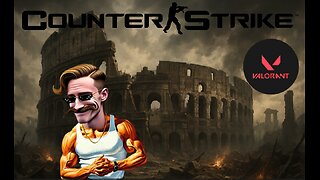Premium Only Content

10,000 B.C. (2008)
10,000 B.C. is a 2008 American action-adventure film co-written, co-produced and directed by Roland Emmerich, co-written, co-scored, and executive produced by Harald Kloser, and starring Steven Strait and Camilla Belle. The film depicts the journeys of a prehistoric tribe of mammoth hunters.
PLOT:
In 10,000 BC, a hunter-gatherer tribe called the Yagahl live in the Ural Mountains. They survived by hunting woolly mammoths, but as the migrations grow more scarce, uncertainty as to their future mounts. When a young blue-eyed girl is brought to their camp, the lone survivor of an attack of "four-legged demons", the Yagahl's shamanistic Neanderthal Old Mother prophesizes that the demons will come to them as well after their last mammoth hunt; the girl, named Evolet, will be betrothed to the champion of this hunt, and the pair will lead the Yagahl into a new way of life. Unwilling to leave the Yagahl's future up to this prophecy, the tribe's chief hunter and bearer of the White Spear leaves on his own to search for another way to save his people; he entrusts the White Spear, his young son D'Leh, and the true purpose of his quest to his friend Tic'Tic. The tribe's children ridicule D'Leh for what they view his father's cowardice, and when he seeks comfort from Evolet, the two begin to fall in love.
Years later, when the mammoths finally return, the adult D'Leh hunts them with his tribe's men under Tic'Tic's leadership and kills one by accident, inadvertently winning the White Spear and Evolet. The next day, horse-mounted riders attack the camp. The warlord, taken by Evolet’s beauty, kidnaps her, enslaves the able-bodied, and kills those who fight back, leaving very few survivors. D'Leh, Tic'Tic, Ka'Ren, and a young boy, Baku, set out to rescue their fellow Yagahl as Old Mother follows their journey in spirit. During an attack on the slavers by terror birds, Evolet is recaptured along with Ka'Ren and Baku, and Tic'Tic is wounded. While hunting, D'Leh falls into a pit, where he helps free a trapped saber-tooth tiger, asking it not to eat him before escaping. Tic'Tic recovers and finds their way to a sedentary Naku village, also attacked by the riders. The surviving villagers nearly attack them until the saber-tooth tiger comes to save D'Leh from the initially hostile Naku. They also learn that D'Leh's father was a guest of the Naku before the riders captured him.
The Almighty threatens to kill Evolet if they do not abandon their rebellion. D'Leh feigns acceptance but easily kills the Almighty with the White Spear, breaking his illusion of godhood. During the ensuing battle, the warlord fatally wounds Evolet, who is then killed by D'Leh. He is devastated when Evolet dies in his arms, but her life is restored in exchange for Old Mother’s, who dies having fulfilled her final duty. With the Almighty dead and his civilization destroyed, the Yagahl bid the other tribes farewell and returned home with seeds collected by D’Leh’s father, given to them by the Naku to begin a new life.
CAST:
Steven Strait as D'Leh, a manak hunter
Camilla Belle as Evolet, D'Leh's wife and the only survivor of a tribe which was destroyed by the "four-legged demons" (fierce warriors on horseback) – spared because of her unique blue eyes
Cliff Curtis as Tic'Tic, D'Leh's mentor and friend.
Joel Virgel as Nakudu, leader of the Naku tribe
Affif Ben Badra as Warlord, the leader of the "Four Legged Demons"
Mo Zinal as Ka'Ren
Lil Tecca as Baku
Marco Khan as One-Eye, Warlord's main henchman
Mona Hammond as Old Mother, the Neanderthal shaman of the Yahgdal
Joel Fry as Lu'Kibu
Reece Ritchie as Moha
Piers Stubbs as Young Moha
Junior Oliphant as Tudu, Nakudu's son
Kristian Beazley as D'Leh's father, who had lived with the Naku tribe and learned agriculture from them
Boubacar Babiane as Quina, leader of another tribe
Farouk Valley-Omar as the High Priest
Tim Barlow as The Almighty, last of three kings and the last of the Atlanteans
Omar Sharif as Narrator
HISTORICAL ACCURACY:
Historical accuracy
The film incorporates numerous anachronisms and inaccuracies in its depiction of prehistoric life. While woolly mammoths and saber-toothed tigers may have existed as late as 10,000 B.C., both species were on the brink of extinction around this time, likely due to a combination of human hunting, disease, and climate change. The film's portrayal of mammoth behavior as being led by a male herd leader is inconsistent with evidence from modern elephant behavior, which suggests that herds were led by older females, with males expelled at puberty.
The inclusion of advanced civilizations, pyramid-like monuments, written language, and metal tools in the narrative is highly inaccurate. Such developments would not emerge until approximately 3,000 B.C., during the urbanization of regions such as the Nile, Euphrates, and Indus river valleys. Early evidence of agriculture dates to around 9,400 B.C., but organized farming and the use of tools like hoes would not have been widespread at the time depicted in the film. Additionally, while some early stone monuments, such as Göbekli Tepe, date to roughly 9,000 B.C., the advanced technology shown in the film, including metal tools and the sextant, is misplaced by several millennia.
PRODUCTION:
Casting
Emmerich opened casting sessions in late October 2005. In February 2006, Camilla Belle and Steven Strait were announced to star in the film, with Strait as the mammoth hunter and Belle as his love. Emmerich decided that casting well known actors would distract from the realistic feel of the prehistoric setting. "If like, Jake Gyllenhaal turned up in a movie like this, everybody would be, 'What's that?'", he explained. The casting of unknown actors also helped keep the film's budget down.
Development
At the 2008 Wondercon, Emmerich mentioned the fiction of Robert E. Howard as a primary influence for the film's setting, as well as his love for the film Quest for Fire and the book Fingerprints of the Gods. He invited composer Harald Kloser to help write the screenplay after he liked his story suggestions to The Day After Tomorrow. When the project received the greenlight from Columbia Pictures, screenwriter John Orloff began work on a new draft of the original script. Columbia Pictures, under Sony Pictures Entertainment, dropped the project due to a busy release calendar, and Warner Bros. picked up the project in Sony's absence. The script went through a second revision with Matthew Sand and a final revision with Robert Rodat.
Production began in early 2006 in South Africa and Namibia. Location filming also took place in southern New Zealand and Thailand. Emmerich wanted to shoot the entire film in Africa but was barred from shooting a certain helicopter scene which led to them going to New Zealand for those shots. Before shooting began, the production had spent eighteen months on research and development for the computer-generated imagery. Two companies recreated prehistoric animals. To cut time (it was taking sixteen hours to render a single frame) 50% of the CGI models' fur was removed, as "it turned out half the fur looked the same" to the director. Filming took place for a total of 102 days, 20 days longer than planned.
Language
Emmerich rejected making the film in an ancient language (similar to The Passion of the Christ or Apocalypto), deciding that it would not be as emotionally engaging. Dialect coach Brendan Gunn was hired by Emmerich and Kloser to create "a half dozen" languages for the film. Gunn has stated that he collaborated informally with film lead Steven Strait to improvise what the languages would sound like. He also used some local African languages and their dialects, including the Oshiwambo language native to Namibia, which can be heard faintly, spoken by the wise blind man.
Alternate ending
In an alternative ending, the scene shifts forward many years into the future, showing Baku's retelling of the story by the camp fire. It ends with a child asking what had happened to the "Mountains of the Gods", and Baku responds, "They were taken back by the sands. Lost to time, lost to man".
Visual and sound effects
The woolly mammoths in the movie were based on elephants and fossils of mammoths, while the saber-toothed cat was based on tigers and ligers (a lion/tiger hybrid). The sounds made by the saber-toothed cat in the movie are based on the vocalization of tigers and lions.
BOXOFFICE:
The world premiere was held on February 10, 2008, at Sony Center on Potsdamer Platz in Berlin.
The film was a moderate success at the box office. In its opening weekend, the film grossed $35.8 million in 3,410 theaters in the United States and Canada, ranking No. 1 at the box office, and grossing over $22 million more than the film in second place, College Road Trip. As of 29 April 2008, it has grossed approximately $268.6 million worldwide—$94.6 million in the United States and Canada and $174 million in other territories—including $17.2 million in Mexico, $13.1 million in Spain, $11.3 million in the United Kingdom, and $10.8 million in China. This also makes it the first film of 2008 to surpass the $200 million mark.
RECEPTION:
On the review aggregator website Rotten Tomatoes, 10% of 147 critics' reviews are positive, with an average rating of 3.4/10. The website's consensus reads: "With attention strictly paid to style instead of substance, or historical accuracy, 10,000 B.C. is a visually impressive but narratively flimsy epic." Metacritic, which uses a weighted average, assigned the film a score of 34 out of 100, based on 29 critics, indicating "generally unfavorable" reviews.
Todd McCarthy of Variety wrote: "Conventional where it should be bold and mild where it should be wild, 10,000 BC reps a missed opportunity to present an imaginative vision of a prehistoric moment." Peter Bradshaw of The Guardian wrote: "Roland Emmerich's great big CGI blockbuster lumbers along like one of the woolly mammoths that roam across the screen." Caroline White, writing for The Times, noted that 10,000 BC is archaeologically inaccurate and contains many factual errors and anachronisms. Composer Thomas Wander won a BMI Film Music Award for his work on the film.
Home media
The film was released on June 17, 2008, in single-disc editions on DVD and Blu-ray Disc in the United States. Best Buy released a 2-disc limited edition along with the DVD and Blu-ray Disc releases. It was released on July 1, 2008, in the United Kingdom. The film grossed $31,341,721 in DVD sales, bringing its total film gross to $300,414,491.
OTHER FILMS:
One Million Years B.C. – A similar film released in 1966
Quest for Fire – A similar film released in 1981
-
 37:55
37:55
Forrest Galante
3 hours agoPrivate Tour of The World's Best Backyard Reptile Zoo
10.1K4 -
 14:38
14:38
Exploring With Nug
1 day ago $8.27 earnedWe Found the Secret That This Lake Has Been Hiding For Decades!
45K7 -
 LIVE
LIVE
SpartanTheDogg
11 hours agoPro Halo Player
632 watching -
 23:23
23:23
MYLUNCHBREAK CHANNEL PAGE
1 day agoAustralia Was Found
56.7K46 -
 1:41:45
1:41:45
The Connect: With Johnny Mitchell
12 hours ago $9.40 earnedMexican Cartels Are Moving MORE Drugs Than Ever, Going To WAR On The Government (Emergency Update)
30.2K4 -
 6:54:01
6:54:01
MissesMaam
7 hours agoFinishin' Red Dead Redemption 💚✨
47K7 -
 34:44
34:44
LFA TV
5 days agoMIRACLES DO HAPPEN!
67.5K1 -
 LIVE
LIVE
GamersErr0r
3 hours ago $0.68 earnedMooning My Community
402 watching -
 2:22:59
2:22:59
Banks Atkin Live
6 hours agoChilling playing Games & Vibin
47.6K1 -
 LIVE
LIVE
Dragoon_B
7 hours agoNothing crazy - just Counter Strike + Valorant
79 watching